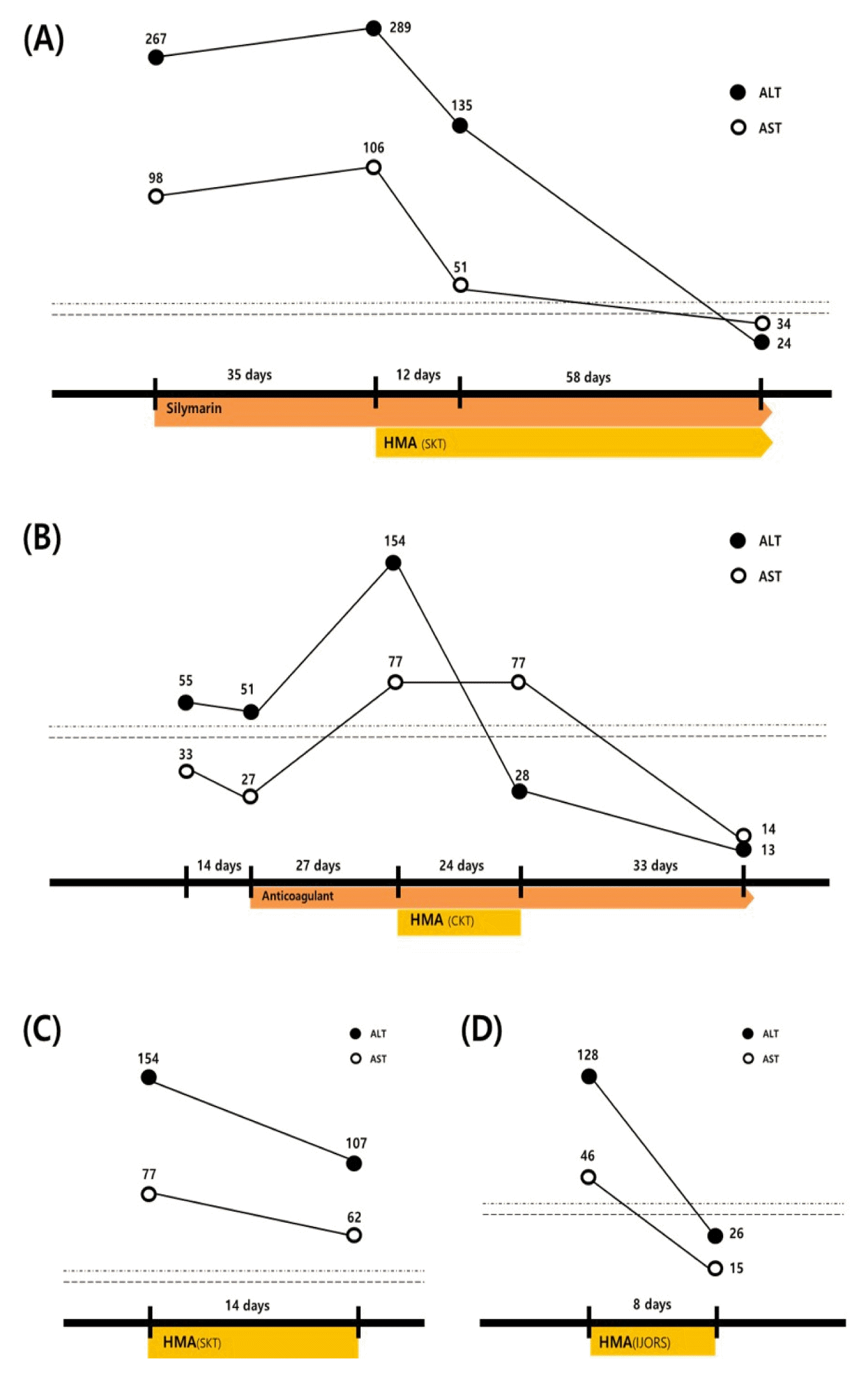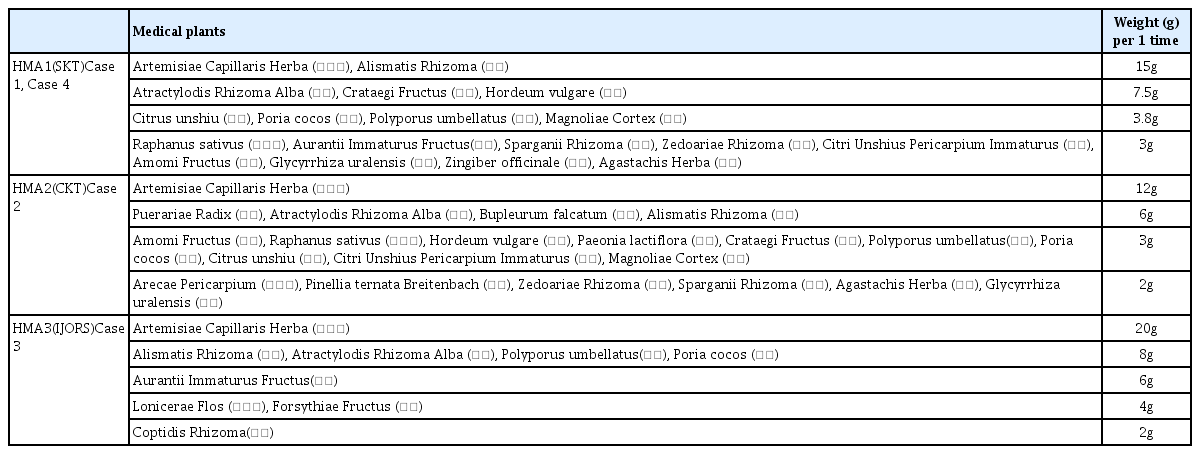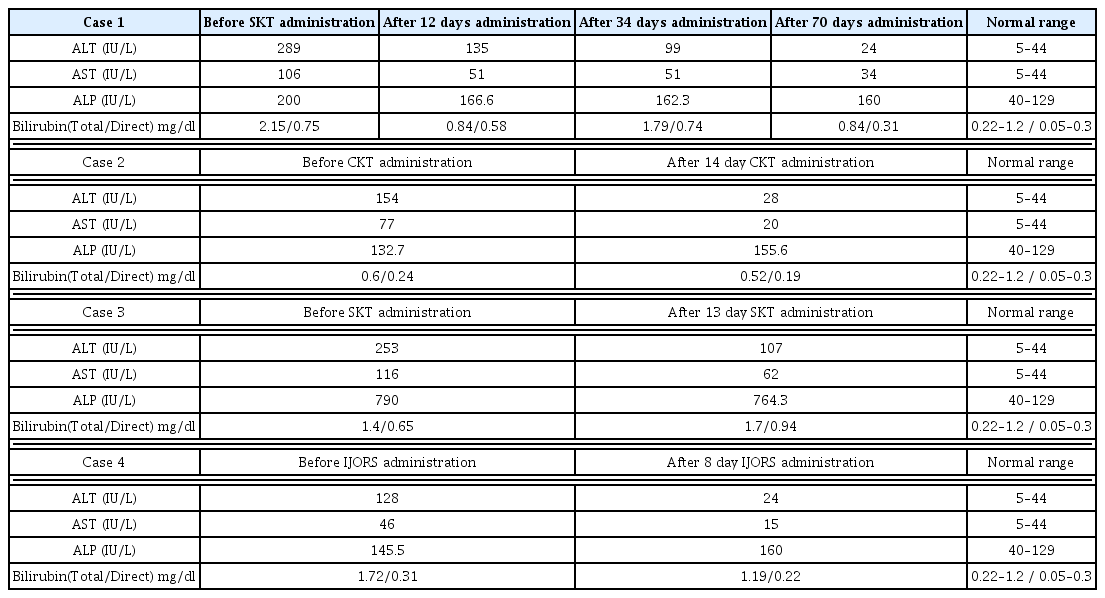References
1. Wegener T. 2017;Patterns and trends in the use of herbal products, herbal medicine and herbal medicinal products. International Journal of Complementary & Alternative Medicine 9(6):317–319.
10.15406/ijcam.2017.09.0031.
2. Barnes PM, Powell-Griner E, McFann K, Nahin RL. 2004;Complementary and alternative medicine use among adults: United States, 2002. Advance data (343):1–19.
4. Yoo TW, Kim BI, Kim JB, Kim DJ, Kim JW, Baik SK. 2007;The survey for the actual condition of drug medication and development of health care cost associated with toxic liver injury in Korean: a multicenter study for the detection and the development of nationwide reporting system of toxic liver injry. Korean J Hepatol 13(1):34–43.
5. Ekor M. 2014. The growing use of herbal medicines: issues relating to adverse reactions and challenges in monitoring safety. Frontiers in pharmacology 4177.
https://doi.org/10.3389/fphar.2013.00177
.
6. Suk KT, Kim DJ, Kim CH, Park SH, Yoon JH, Kim YS, et al. 2012. A prospective nationwide study of drug-induced liver injury in Korea. The American journal of gastroenterology 107(9)1380–1387.
https://doi.org/10.1038/ajg.2012.138
.
7. Kim NH, Jung HY, Cho SY, Park SU, Park JM, Ko CN. 2011. Liver enzyme abnormalities during concurrent use of herbal and conventional medicines in Korea: a retrospective study. Phytomedicine: international journal of phytotherapy and phytopharmacology 18(14)1208–1213.
https://doi.org/10.1016/j.phymed.2011.06.026
.
8. Lee J, Shin JS, Lee YJ, Kim MR, Shin BC, Lee JH, et al. 2019. Battle Over Herb-Induced Liver Injury: Low Prevalence Confirmed through Secondary Evaluation and Research Team’s Clarifying Rebuttal to Unwarranted Public Claims. Journal of alternative and complementary medicine (New York, NY) 25(3)260–264.
https://doi.org/10.1089/acm.2018.0253
.
9. Cho JH, Oh DS, Hong SH, Ko H, Lee NH, Park SE, et al. 2017. A nationwide study of the incidence rate of herb-induced liver injury in Korea. Archives of toxicology 91(12)4009–4015.
https://doi.org/10.1007/s00204-017-2007-9
.
10. Chu H, Park C, Kim C, Sung K, Lee S. Effectiveness and safety of Injinoryung-San-Gagambang (Yinchen Wuling powder) decoctionon stroke patients with elevated serum liverenzymes. Medicine 2018;97(51):e13577.
11. Chu H, Park C, Kim C, Sung KK, Lee S. 2018. Effectiveness and safety of Injinoryung-San-Gagambang (Yinchen Wuling powder) decoction on stroke patients with elevated serum liver enzymes: Three case reports. Medicine 97(51)e13577.
https://doi.org/10.1097/MD.0000000000013577
.
12. Stickel F, Schuppan D. 2007. Herbal medicine in the treatment of liver diseases. Digestive and liver disease: official journal of the Italian Society of Gastroenterology and the Italian Association for the Study of the Liver 39(4)293–304.
https://doi.org/10.1016/j.dld.2006.11.004
.
14. Kim HS, Lee SH, Kim H, Lee SH, Cho JH, Lee H, et al. 2016. Statin-related aminotransferase elevation according to baseline aminotransferases level in real practice in Korea. Journal of clinical pharmacy and therapeutics 41(3)266–272.
https://doi.org/10.1111/jcpt.12377
.
15. Barnes PM, Bloom B, Nahin RL. 2008;Complementary and alternative medicine use among adults and children: United States, 2007. National health statistics reports (12):1–23.
17. Lee WJ, Kim HW, Lee HY, Son CG. 2015. Systematic review on herb-induced liver injury in Korea. Food and chemical toxicology: an international journal published for the British Industrial Biological Research Association 8447–54.
https://doi.org/10.1016/j.fct.2015.06.004
.
18. Lee J, Shin JS, Kim MR, Byun JH, Lee SY, Shin YS, et al. 2015. Liver enzyme abnormalities in taking traditional herbal medicine in Korea: A retrospective large sample cohort study of musculoskeletal disorder patients. Journal of ethnopharmacology 169407–412.
https://doi.org/10.1016/j.jep.2015.04.048
.
19. Chan K, Zhang H, Lin ZX. 2015. An overview on adverse drug reactions to traditional Chinese medicines. British journal of clinical pharmacology 80(4)834–843.
https://doi.org/10.1111/bcp.12598
.
20. Liang Z, Chen X, Shi J, Hu H, Xue Y, Ung COL. 2021. Efficacy and safety of traditional Chinese medicines for non-alcoholic fatty liver disease: a systematic literature review of randomized controlled trials. Chin Med 16(9)1–38.
https://doi.org/10.1186/s13020-020-00422-x
.
21. Zhao CQ, Zhou Y, Ping J, Xu LM. 2014. Traditional Chinese medicine for treatment of liver diseases: progress challenges and opportunities. Journal of integrative medicine 12(5)401–408.
https://doi.org/10.1016/S2095-4964(14)60039-X
.
22. Takahashi H, Maruyama K. 1993;Clinical aspects of Kampo treatment for alcoholic liver disease. Igaku no Ayumi (J Clin Exp Med) 167:811–814.
(in Japanese).
23. Higuchi K, Watanabe A. 2000;Study on liver cancer-preventive effect of juzentaihoto in patients with liver cirrhosis. Methods Kampo Pharmacol 5:29–33.
(in Japanese).
24. Okabayashi T, Mimura H, Orita K. 1989;Usefulness of shosaikoto (TJ-9) inthe treatment of postoperative liver dysfunction. Prog Med 9:851–855.
(in Japanese).
25. Chtourou Y, Garoui E, Boudawara T, Zeghal N. 2013. Therapeutic efficacy of silymarin from milk thistle in reducing manganese-induced hepatic damage and apoptosis in rats. Human & experimental toxicology 32(1)70–81.
https://doi.org/10.1177/0960327112455674
.
26. Lee IW, Choi HY, Lee JH, Park SD, Kim SM, Ku SK, et al. 2016. Saeng-Kankunbi-Tang (生肝健脾汤) protects liver against oxidative damage through activation of ERK/Nrf2 pathway. Chinese Journal of Integrative Medicine 22(8)619–28.
https://doi.org/10.1007/s11655-016-2466-5
.
28. Qamar A, Vaduganathan M, Greenberger NJ, Giugliano RP. 2018. Oral Anticoagulation in Patients With Liver Disease. Journal of the American College of Cardiology 71(19)2162–2175.
https://doi.org/10.1016/j.jacc.2018.03.023
.
30. Jang E, Kim BJ, Lee KT, Inn KS, Lee JH. 2015. A Survey of Therapeutic Effects of Artemisia capillaris in Liver Diseases. Evidence-based complementary and alternative medicine: eCAM 2015. 728137.
https://doi.org/10.1155/2015/728137
.
31. Heo J. 2009. Donguibogam Seoul: Bubin PUBLISHERS CO. p. 142.
32. Lee JM. 1964. Dongeuisusebowon Seoul: Shinil Publishing Co.
33. Kang WS, Lee JH, Wo HJ. 1999;The effect of Injin and Injinsaryungsangagambang on Liver Cell Viability, Liver Cell Cycle Progression and DNA Damage-induced Apoptosis. J Korean Med 20(1):91–105.
34. ANGP , GIMLAI D, WANG L, ZHANG S, YEZ , LIU J, et al. 2019;Survival Analysis of Yang Jaundice-Yin-Yang Jaundices-Yin Jaundice Syndrome Differentiation Combined with Western Medicine in the Treatment of Patients with HBV-related Acute-on-chronic Liver Failure. Journal of Traditional Chinese Medicine 60(7):582–586.




